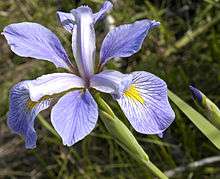Iris virginica
| Iris virginica Virginia iris | |
|---|---|
 | |
| Scientific classification | |
| Kingdom: | Plantae |
| Clade: | Angiosperms |
| Clade: | Monocots |
| Order: | Asparagales |
| Family: | Iridaceae |
| Genus: | Iris |
| Species: | I. virginica |
| Binomial name | |
| Iris virginica L. | |
| Synonyms | |
| |
Iris virginica, with the common name Virginia iris, is a perennial species of flowering plant, native to eastern North America.
It is common along the coastal plain from Florida to Georgia in the Southeastern United States. [2]
It is one of the three Iris species in the Iris flower data set outlined by Ronald Fisher in his 1936 paper "The use of multiple measurements in taxonomic problems" as an example of linear discriminant analysis.[3]
Description
Iris virginica is a perennial plant. The plant has 2 to 4 erect or arching, bright green, lance-shaped leaves that are flattened into one plane at the base. Leaves are 1–3 cm wide and are sometimes longer than the flower stalk. The fleshy roots (1–2 cm in diameter) are rhizomes that spread underground. Pale brown, variably shaped seeds are born in three-part fruit capsules (3–6 cm long, 1–2 cm wide). [4]
The slightly fragrant flowers (4 cm long, 7 cm across) consist of 3 horizontal sepals, or "falls", and 3 erect petals. The petals and sepals can vary in color from dark-violet to pinkish-white. The sepals have a splash of yellow to yellow-orange at the crest. Each plant has 2 to 6 flowers that bloom from April to May upon a single, erect, 30-90 cm tall stalk. The stalk is sometimes branched and has a slight zigzag appearance. [4]
Uses
The Cherokee use this medicinal plant for traditional medicine uses. The root is pounded into a paste that is used as a salve for skin. An infusion made from the root is used to treat ailments of the liver, and a decoction of root is used to treat "yellowish urine". [5] [6]
It may be one of the Iris species used by the Seminole to treat "shock following alligator-bite".[2]
References
- ↑ "Iris virginica L. is an accepted name". theplantlist.org (The Plant List). 23 March 2013. Retrieved 13 April 2015.
- 1 2 USDA: Iris virginica
- ↑ R. A. Fisher (1936). "The use of multiple measurements in taxonomic problems" (PDF). Annals of Eugenics. 7 (2): 179–188. doi:10.1111/j.1469-1809.1936.tb02137.x.
- 1 2 Missouri Botanical Garden: Iris virginica
- ↑ University of Michigan at Dearborn: Native American Ethnobotany of Iris virginica
- ↑ Hamel, Paul B. and Mary U. Chiltoskey 1975 Cherokee Plants and Their Uses -- A 400 Year History. Sylva, N.C. Herald Publishing Co. (p. 41)
External links
- USDA Plants Profile for Iris virginica (Virginia iris)
- Kemper Center for Home Gardening.org: Iris virginica (Virginia iris)